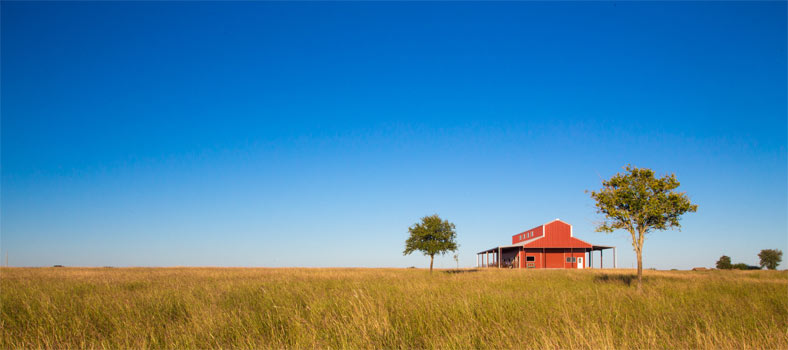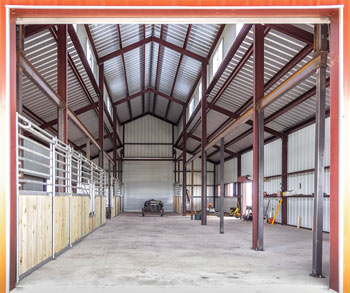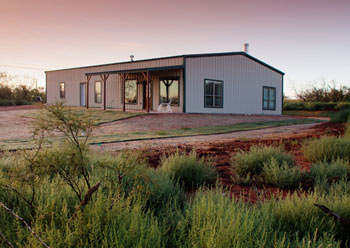
Photo by Janet Hunter
Brady and Brit Russell's Central Texas barndominium
Research “barndominium” online and the pages of search results will tell the story. It seems everyone is talking about barndominiums, or barndos, as they are nicknamed. In less than a decade, barndos have established a firm footing across the rural landscape for purposes as diverse as the designs and finishes themselves.
Also known as a barn house, a barndominium is a dual- or multi-purpose structure that encompasses living space and a barn, workshop or other workspace under a single roof.
If you are considering building a barndo, here are three steps to help guide your project.
Design with the end in mind.
Think about how you plan to use the structure, and the dimensions you will need to accommodate those activities — factors such as ceiling height, roof pitch, door widths and storage space. Will your living space be located upstairs, incorporated as part of the first-floor slab, or a combination of both? How will you draw natural lighting into interior spaces, and heat and cool it efficiently?
“The metal building dealers have the design expertise — that is their sole job — so once you select the metal supplier, rely on them for design advice,” says Shane Ward, Amarillo-area homebuilder. Once you have determined the footprint, an architect or draftsman can draw the interior living quarters to your specifications.
“Do your due diligence on the design, but balance that with the budget you have in mind,” he advises.

Photo by Janet Hunter
Pictured before completion, the Russells’ barndo features horse stalls on the left. Living space will be on the right and on the second floor, yet to be built.
To speed the process and minimize costs, start with sketches of your own.
“We knew what we wanted but worked with an architect to spruce up our plan,” says Barry Walker, a Dripping Springs, Texas, barndo owner and Capital Farm Credit customer.
Lastly, begin gathering ideas long before the project starts. Keep a notebook of tips and ideas that catch your eye: photos, magazine ads, paint color swatches and lighting fixture brochures, for example. Don’t overlook the endless inspiration that can be found online. Brit Russell gathered interior finish ideas from Pinterest.
“I’m a huge Pinterest fan, and have been pinning ideas from House and Barn and Cowboys and Indians for ideas,” she says.
“I want people to see this, and be wowed,” she says of her Central Texas barndo.
Partner with a trusted contractor.
Integrity and experience are key traits to seek in the builder you choose. Most bankers won’t loan to individuals who want to build themselves, so do your homework before choosing a contractor.
“Ask others for referrals. Check their reputation. Spend some time with the person,” advises Ward. “Is this someone you can trust, someone you can have a relationship with for many months?”
Walker and his wife, Kerry, took a hybrid approach, hiring a “help you build” builder to handle the plan take-offs, oversee the bid process with subcontractors and supply the subcontractors. She acted as the general contractor, overseeing the dayto- day work progress, scheduling subcontractors and acting as quality control. Throughout the process, she lived nearby on the property so that she could be onsite daily.
“It was fun, but time-consuming,” she says.
Secure financing.
Many aspiring barndominium owners are surprised to learn that commercial banks are reluctant to finance them.
“Barndos are still fairly new to the market, and commercial banks don’t have buyers for these loans in the secondary market, or the expertise to appraise them,” says Trent Tyson, loan officer at Panhandle-Plains Land Bank in Amarillo. “Customers tell us that the banks actually tell them to come to us. It has been a great way for Farm Credit to be introduced to new customers.”
Like other Farm Credit lenders, Tyson is seeing an upswing in loan applications for barndos.
“In the past few years, we have financed 15 to 20 — just in our association,” he says. That volume ensures an ample inventory of comparable appraisals, a challenge that traditional banks haven’t overcome.
“I first went to a commercial bank for my financing, and they wanted to appraise it compared to a 1,200-square-foot house with garage,” says Kari Beth Nash. Instead, she chose to refinance her land into a barndo loan with Mississippi Land Bank.
Nash’s solution — to use equity in the land to help cover the down payment — is a common one, Tyson says. Typical loan terms are 15 years with a variable interest rate and a 25 percent down payment.
“Through our cash patronage program for member-borrowers, we’ve paid 20 percent cash patronage on average for 10 years,” says Tyson. “That makes us very competitive with commercial banks.”
- Sue Durio
What Is a Barndo?

Photo by Russell Graves
Shane Ward's barndominium
The multi-purpose barndominium concept is not new — over the centuries, people often have shared living space with their animals, crops and tools. What’s different today are the design and materials used.
Most American barndos today are built on a steel frame and covered with metal siding, although some feature a traditional wood frame and other siding materials. They may offer other unusual features such as roll-up doors and enough space to accommodate large vehicles and equipment. And when the barndo is a metal structure, the owner may have the flexibility to finish out the interior space as budget allows and needs change.
Here are some key aspects of this type of construction:
- Usually quicker to build than a conventional home
- Construction costs may be less, depending on features and finishing materials
- Lower maintenance costs
- Often more energy-efficient
- Fire resistant
- Pest resistant
- Design flexibility — less permanent than a conventional home